Have you ever wondered how much does a toilet weigh? Perhaps you’re planning a DIY bathroom renovation and need to know just how much muscle you’ll need to move it out. Or maybe you’re just curious about the total weight of your bathroom fixtures.
Whatever the reason, you’d be surprised to know that toilets are heavier than you might expect, especially the older models. So, just how much does a toilet weigh?
Read on and explore the weight of different types of toilets, what factors can impact the weight, and some tips on how to move a toilet safely.
Use links below for easy navigation
How Heavy Are Different Toilet Designs?
After our thorough research and study, we found that an average toilet weighs up to 100-115 lbs. But different designs have different weights. Let us see how heavy different toilet designs are.
One-Piece Toilet
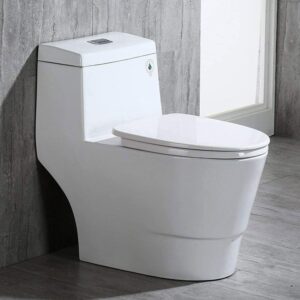
In a one piece toilet design, the tank is permanently attached to the bowl, which results in a compact and seamless structure.
However, due to this structure, one-piece toilets tend to be heavier than other toilet designs. On average, a standard one-piece toilet weighs around 80-120 lbs. And an average lightweight one-piece model has 70-90 lbs of weight.
The primary material used in the construction of one-piece toilets is ceramic, vitreous china. While these materials are known for their durability and longevity, they also contribute to the weight of the toilet, as both the tank and bowl are constructed from the same material.
Two-Piece Toilet
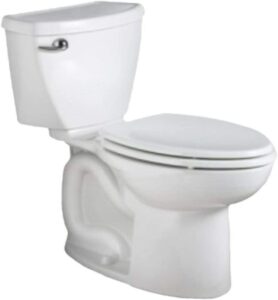
In a two-piece toilet design, the bowl and the tank are two different units that are bolted together while installing it. For this very reason, two-piece toilets are comparatively lighter in weight than one-piece toilets.
An average two-piece toilet weight is 60-100 lbs. As the tank is the unit that holds the water to flush, it is heavier than the bowl, which is hollow, so it weighs less. Both units are made of ceramic or porcelain material to provide durability and longevity.
Related: Non clogging toilets
Floor Mounted Toilet
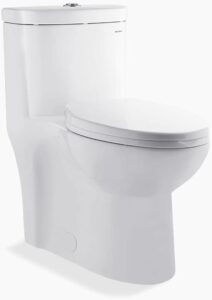
Most toilets available on the market are designed to be floor-mounted, which means they rest directly on the bathroom floor. The weight of these toilets can vary depending on factors such as their size, design, and the materials they are made from.
On average, floor-mounted toilets tend to weigh between 60 to 120 lbs. The weight can vary within this range, with smaller toilets generally being lighter and larger toilets weighing more.
These toilets are designed so the weight is distributed evenly on the floor, and the center of gravity matches the center of gravity of the person sitting on it for a balanced seat.
Related: Toto Drake Vs Drake II
Wall Hung Toilet
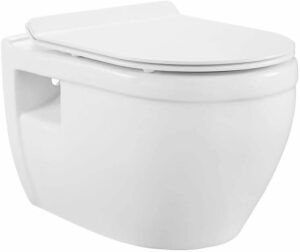
Wall hung toilets, also known as floating or wall-mounted toilets, are fixtures attached to the wall rather than resting on the floor. This unique design allows space-saving benefits in the bathroom, as it frees up floor space and provides a sleek, modern look. However, due to the hidden tank behind the wall, wall-hung toilets tend to be heavier than other toilet designs.
The average weight of wall-hung toilets ranges from 60 to 120 lbs. Despite their weight, these toilets often have lighter tanks than other toilet designs. It is possible because the tank is hidden and supported by the wall, reducing the overall weight.
Portable Toilet
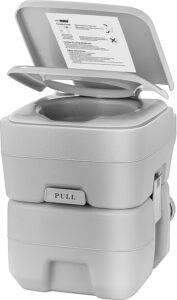
Portable toilets are much lighter than other toilets. These toilets are made of plastic for convenient transportation. The average of a portable toilet is between 10 lbs to 50 lbs.
There are certain features that contribute to their weight. These toilets include a waste holder, a tank, and a seat. Though all these units are made of plastic, they significantly contribute to the weight.
The type of plastic used also contributes to the weight of these toilets. High-quality plastic is strong and thus heavier than low-quality plastic.
Related: Best toilets for seniors
Factors That Determine How Much Does a Toilet Weigh?
Now you may be wondering how come these toilets have different weights when they have the same functionality. The following are the major factors that determine how much does a toilet weigh.
Design
The design of a toilet can impact its weight, as different designs have different structural considerations. For example, one-piece toilets tend to be heavier than two-piece toilets due to their compact design, as the tank and bowl are molded together as one unit.
Wall-hung toilets are another design that can be heavy, as their water tank is hidden behind the wall. However, floor-mounted toilets are often the most common toilet design, with their weight varying according to size and material.
Size
The size of a toilet is a critical factor in determining how much does a toilet weigh.
Elongated toilets, which have a more oval-shaped bowl, typically weigh more than their round bowl counterparts. It is primarily because elongated toilets require more material to produce, resulting in a heavier overall weight.
Additionally, larger toilets, regardless of their bowl shape, will generally weigh more than smaller ones due to the increased material and surface area required.
Brand
Toilet brands have varying design approaches and use unique materials and manufacturing processes, which ultimately impact the weight of their products. Some brands may prioritize creating lightweight toilets to appeal to customers looking for easy installation or portability.
Meanwhile, other brands may opt to use high-density materials like porcelain or ceramic to enhance the durability and longevity of their products, resulting in a heavier finished product.
Related: Woodbridge toilet reviews
Material
The type of material used for a toilet’s construction is a significant factor in determining how much does a toilet weigh.
Porcelain, ceramic, and glass are common materials used in the production of toilets, with each having a unique density and weight. Ceramics1 is the most commonly used material due to its high density, which gives it a heavyweight.
Additionally, porcelain is commonly used in higher-end toilets as it offers both durability and a polished finish. Glass is a newer material that provides a transparent and modern look but is not as commonly used due to its fragility.
Related: How much does a porcelain toilet weigh?
How Much Some Popular Toilets Weigh?
American Standard Champion 4: 118 lbs
Kohler Santa Rosa: 102 lbs
Kohler Wellworth: 86.3 lbs
Horow Smart Toilet: 105.6 lbs
Swiss Madison SM-1T205: 94 lbs
Convenient Height Model S: 120 lbs
VOVO STYLEMENT TCB-090SA: 115 lbs
Deer Valley DV-1F026: 99.43 lbs
WOODBRIDGE T-0019-CH: 119 lbs
TOTO CST454CEFG#01 Drake: 94 lbs
Mansfield 135.160 Toilet: 72 lbs
Kohler K-3999-0 Highline: 93 lbs
Can An Average Person Lift a Toilet?
The weight of toilets can vary with different sizes, designs, materials, and brands. Generally, the weight of an average toilet ranges between 80 and 120 lbs, although some models may weigh up to 200 lbs or more.
While it is technically possible for an average person to lift a toilet, it may be challenging due to its weight and size. Lifting a toilet requires proper technique and caution to prevent injury or damage to the fixture.
We recommend asking for someone’s assistance in lifting the toilet or using lifting equipment such as straps or a dolly for added safety.
But if you have experience of lifting something heavy, then it should not be a problem for you. You can easily carry a two-piece toilet on your own because of the detached tank and bowl.
Lifting one-piece toilets is quite challenging as their compact design makes them heavy. While portable toilets are lightweight and designed for transportation, so lifting them doesn’t pose any challenge.
Tips On How To Lift a Toilet By Yourself
Lifting a toilet by yourself can be challenging. Here are some tips for safely lifting a toilet on your own:
1. Gather the right tools: Use heavy-duty gloves, an adjustable wrench, and a drop cloth to protect the floor.
2. Loosen connections: Disconnect the water supply line and loosen the nuts that secure the toilet to the floor. Prepare a drop cloth to catch any spills.
3. Lift with proper technique: Support the midsection of the toilet bowl with one hand and the tank with the other. Use your legs to lift, not your back.
4. Carry cautiously: Lift the toilet slowly, keeping it close to your body. Watch out for sharp or protruding parts.
5. Lower carefully: Lower the toilet gently to avoid damage when moving or placing it.
Remember, if the toilet is too heavy, ask for help or use lifting equipment.
Conclusion
To sum it up, the weight of a toilet can vary significantly depending on factors such as its type, design, materials used, and brand. Generally, a one-piece toilet is comparatively heavier than a two-piece one due to its compact construction.
The weight of a toilet plays a crucial role during installation, transportation, and maintenance. Various elements influence it, including the materials used for the bowl and tank, water capacity, and any additional features.
When selecting a toilet, it is essential to consider how much does a toilet weigh to ensure proper installation and functionality in the desired space. Considering weight is necessary for choosing a suitable toilet.
- https://www.sciencelearn.org.nz/resources/1769-what-are-ceramics ↩︎


